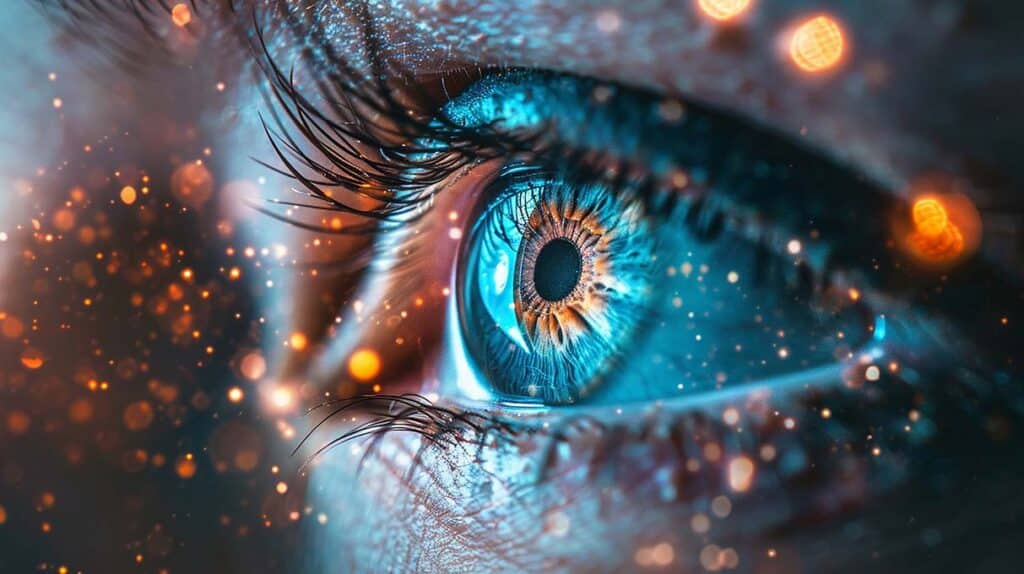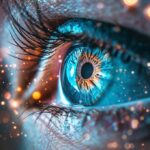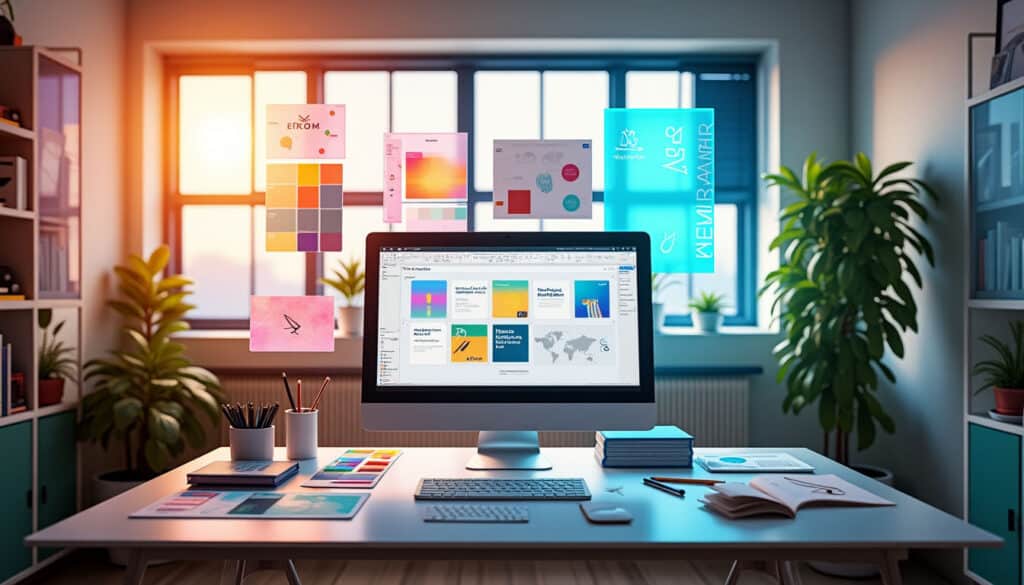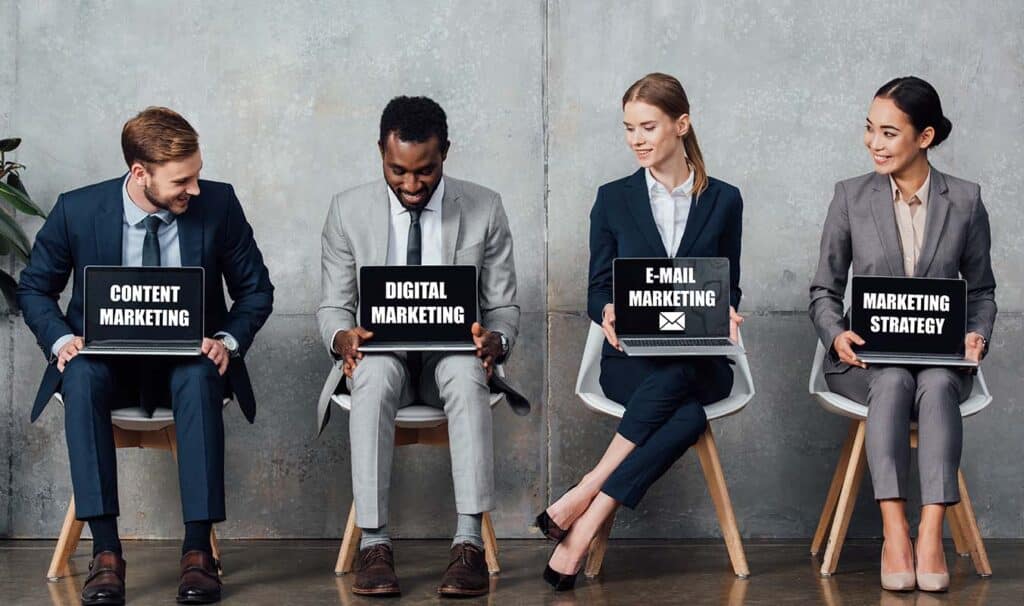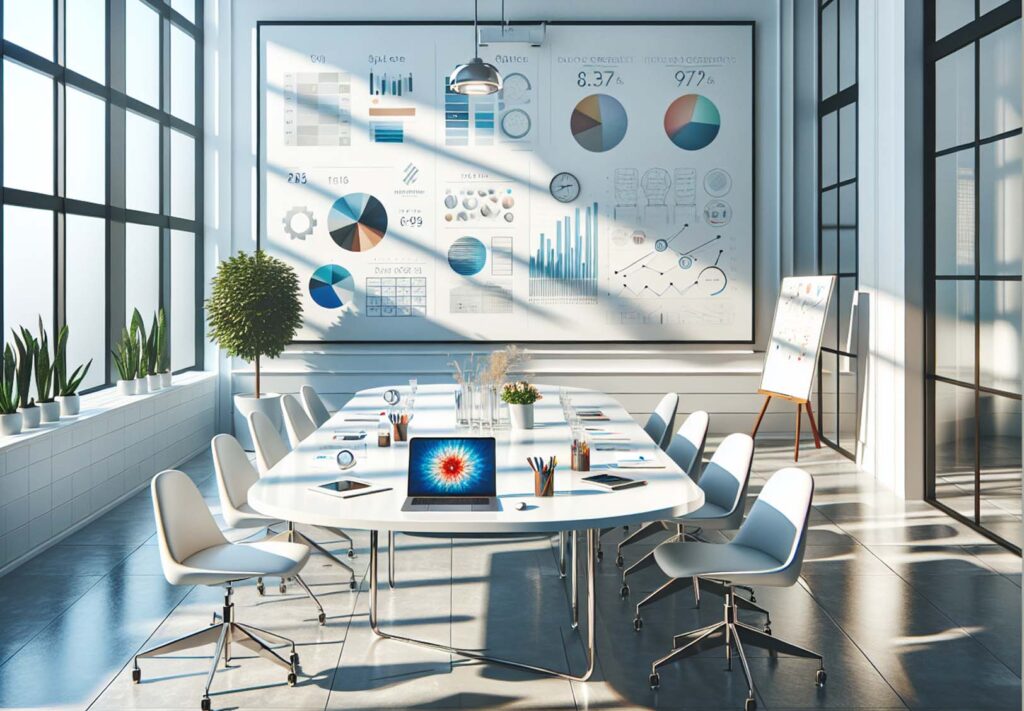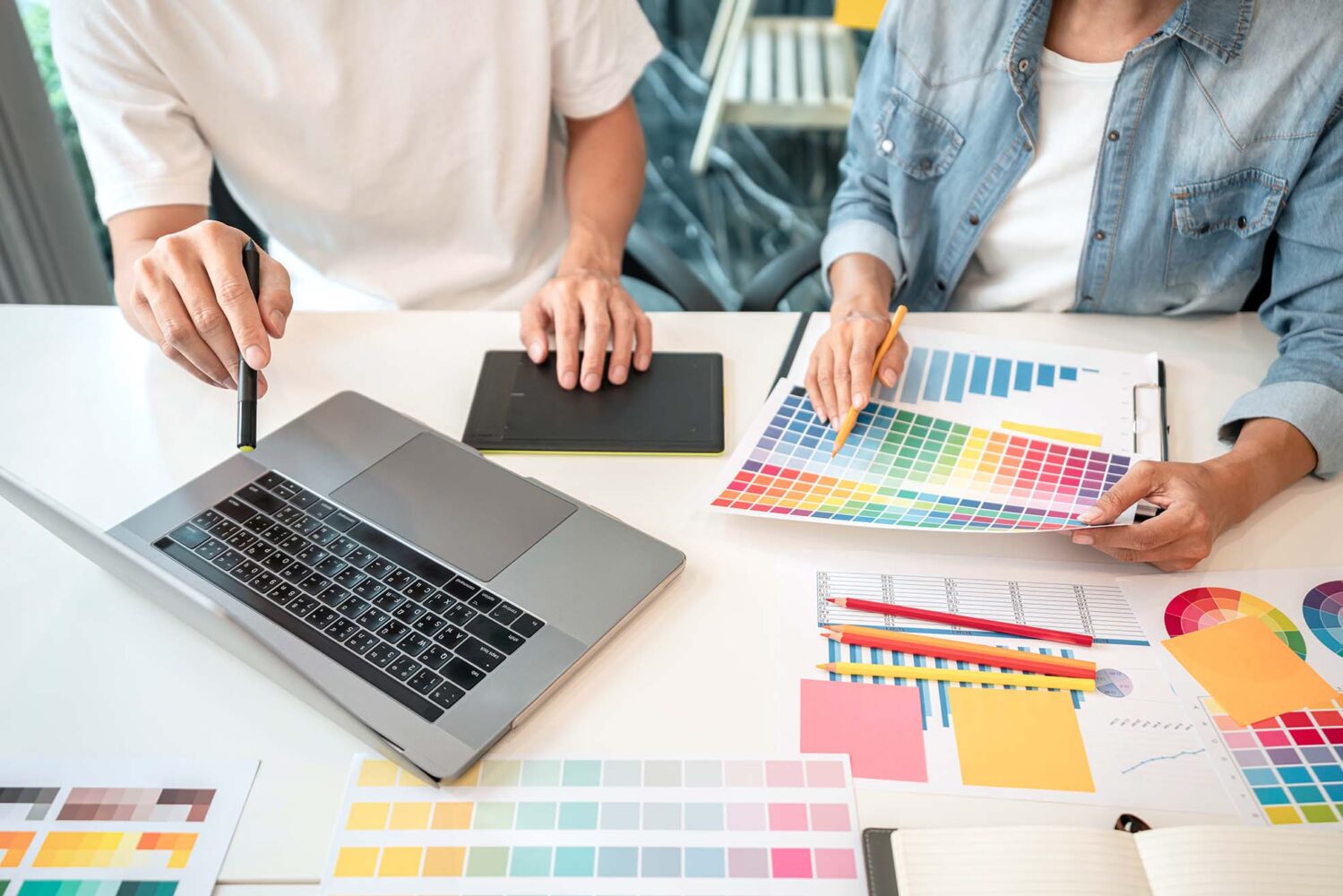
As we approach 2025, graphic design continues to evolve at a breakneck pace. Designers and creative agencies are pushing boundaries, embracing cutting-edge technologies, and reimagining visual communication in ways that captivate and inspire. In this comprehensive exploration, we’ll dive into the most influential graphic design trends that are set to dominate the industry in 2025. From AI-driven innovations to nostalgic revivals, these trends are reshaping how brands connect with their audiences and how designers approach their craft.
Buckle up, fellow creatives! We’re about to embark on a thrilling journey through the visual wonders that await us in the near future. Whether you’re a seasoned designer looking to stay ahead of the curve or a business owner seeking to elevate your brand’s visual identity, this guide will equip you with the insights you need to make a lasting impression in the dynamic world of graphic design.
The Rise of AI-Powered Design
Artificial Intelligence is no longer just a buzzword – it’s becoming an indispensable tool in the graphic designer’s arsenal. As we approach 2025, AI is set to revolutionize the creative process, offering unprecedented possibilities and efficiencies.
AI-Driven Creativity and Automation
AI algorithms are evolving to understand design principles, color theory, and composition. This advancement allows for the rapid generation of design concepts, giving designers a springboard for their creativity. Imagine having an AI assistant that can produce dozens of logo variations based on your initial sketches, or generate custom illustrations that align perfectly with your brand guidelines.
However, it’s crucial to note that AI is not replacing human designers. Instead, it’s augmenting their capabilities, allowing them to focus on higher-level creative decisions and strategic thinking. The synergy between human intuition and machine efficiency is creating a new paradigm in graphic design.
Personalized Design Experiences
One of the most exciting applications of AI in modern graphic design is the ability to create personalized visual experiences at scale. By analyzing user data and preferences, AI can help brands tailor their visual content to individual consumers. This could manifest in dynamically generated social media posts, personalized product packaging, or even adaptive website designs that change based on user behavior.
Ethical Considerations and Creative Ownership
As AI becomes more prevalent in the design process, important questions arise about creative ownership and the ethical use of AI-generated content. Designers and agencies will need to navigate these waters carefully, establishing clear guidelines for AI usage and ensuring transparency with clients about the role of AI in their creative process.
Nostalgic Futurism: Blending Past and Future
In 2025, we’re witnessing a fascinating trend that marries the comfort of nostalgia with the excitement of futuristic design. This unique blend creates visuals that feel both familiar and cutting-edge, appealing to a wide range of audiences.
Retro-Futuristic Typography
Typography is taking center stage in this trend, with designers experimenting with fonts that evoke vintage sci-fi aesthetics while incorporating modern design principles. Think sleek, space-age letterforms with a touch of 1980s neon or art deco-inspired typefaces reimagined for the digital age.
Neo-Brutalism Meets Cyberpunk
The raw, unpolished aesthetic of brutalism is getting a futuristic makeover. Designers are combining the stark, utilitarian elements of brutalist design with the neon-soaked, high-tech visuals of cyberpunk. This creates a striking visual language that’s perfect for brands looking to make a bold statement.
Analog Textures in Digital Spaces
To balance the sleekness of modern design, there’s a growing appreciation for analog textures and imperfections. Grainy filters, film scratches, and vintage color palettes are being skillfully integrated into digital designs, adding depth and character to otherwise pristine compositions.
Immersive 3D and Virtual Experiences
As technology continues to advance, the line between physical and digital realities is blurring. Graphic designers are at the forefront of this revolution, creating immersive experiences that transport viewers into new worlds.
Hyper-Realistic 3D Design
The demand for hyper-realistic 3D design is skyrocketing. From product visualizations to environmental design, designers are pushing the boundaries of what’s possible with 3D rendering. This trend is particularly impactful in e-commerce, where lifelike 3D product models are enhancing the online shopping experience.
AR and VR in Branding
Augmented Reality (AR) and Virtual Reality (VR) are no longer confined to gaming and entertainment. Forward-thinking brands are incorporating these technologies into their visual identities. Imagine business cards that come to life when viewed through a smartphone or virtual showrooms that allow customers to interact with products in a fully immersive environment.
Interactive Data Visualization
As data becomes increasingly complex, designers are finding innovative ways to make it accessible and engaging. Interactive 3D data visualizations are becoming more prevalent, allowing users to explore and understand information in a more intuitive, spatial manner.
Sustainable and Eco-Conscious Design
With environmental concerns at the forefront of global consciousness, graphic design is embracing sustainability in both aesthetics and practice.
Eco-Friendly Visual Language
Designers are developing visual languages that communicate sustainability and environmental responsibility. This includes the use of earthy color palettes, organic shapes, and nature-inspired motifs. Brands are moving away from glossy, artificial aesthetics in favor of more natural, authentic visual representations.
Minimalism with Purpose
The minimalist trend is evolving to focus on purposeful design that reduces visual clutter and, by extension, cognitive load. This approach not only creates cleaner, more impactful designs but also aligns with the principles of digital sustainability by reducing the energy consumption associated with complex graphics.
Upcycled and Recycled Design Elements
In a nod to sustainability, designers are incorporating upcycled and recycled elements into their work. This could manifest as textures derived from recycled materials, or digital designs that mimic the aesthetics of repurposed objects. This trend not only looks great but also tells a powerful story about a brand’s commitment to environmental stewardship.
Dynamic and Adaptive Brand Identities
Static logos and rigid brand guidelines are becoming a thing of the past. In 2025, brands are embracing fluidity and adaptability in their visual identities.
Shape-Shifting Logos
Logo creation and logo design services are rapidly evolving to meet the demands of today’s digital-first world. Responsive logos that change based on context are gaining traction. These dynamic identities can adapt to different screen sizes, color backgrounds, or even animate in digital environments. This flexibility ensures that a brand’s visual identity remains effective and recognizable across various platforms and applications.
Contextual Color Palettes
Brand color palettes are expanding beyond a fixed set of hues. Designers are creating intelligent color systems that can adapt to different cultural contexts, seasons, or even individual user preferences. This approach allows brands to maintain consistency while also demonstrating versatility and cultural sensitivity.
AI-Powered Brand Evolution
Some forward-thinking brands are experimenting with AI-driven brand identities that evolve over time. These systems use machine learning to analyze market trends, user engagement, and other data points to subtly update visual elements, ensuring the brand stays fresh and relevant without losing its core identity.
Inclusive and Accessible Design
As society becomes more aware of the importance of inclusivity, graphic design is playing a crucial role in creating visual communications that are accessible to all.
Universal Design Principles
Designers are increasingly adopting universal design principles to ensure their work is accessible to people with diverse abilities. This includes considerations for color contrast, font legibility, and alternative text for images. The goal is to create designs that are not just visually appealing but also functional for everyone.
Diverse Representation in Imagery
Stock photos of homogeneous groups are out. Brands and designers are prioritizing authentic, diverse representation in their visual content. This includes showcasing a wide range of ethnicities, body types, ages, and abilities in illustrations, photography, and iconography.
Culturally Sensitive Design
Global brands are recognizing the importance of culturally sensitive design. This involves creating visual systems that can be easily adapted for different cultural contexts without losing their core identity. It also means being mindful of cultural symbolism and avoiding potentially offensive imagery or color combinations.
The Evolution of Typography
Typography continues to be a cornerstone of graphic design, and in 2025, it’s undergoing some exciting transformations.
Variable Fonts and Kinetic Typography
Variable fonts, which allow for infinite variations in weight, width, and style within a single font file, are becoming more sophisticated. This technology is enabling designers to create dynamic, responsive typography that adapts to different screen sizes and contexts. Kinetic typography, where text moves and transforms, is also gaining popularity, particularly in digital and video content.
Hand-Drawn and Imperfect Type
In contrast to the precision of digital typography, there’s a growing appreciation for hand-drawn and imperfect typefaces. These fonts add a human touch to designs, creating a sense of authenticity and personality. Brands are using custom, hand-drawn typography to stand out in a sea of digital perfection.
Experimental Layouts and Text as Image
Traditional grid layouts are being challenged by more experimental approaches to text arrangement. Designers are treating typography as a visual element in its own right, creating compositions where text and image blend seamlessly. This trend is particularly evident in editorial design and brand campaigns.
Data-Driven Design and Personalization
As data collection and analysis become more sophisticated, designers are leveraging this information to create more targeted and effective visual communications.
Personalized Visual Experiences
Brands are using data to create personalized visual experiences for their customers. This could involve dynamically generated graphics based on user behavior, or customized color schemes that align with individual preferences. The goal is to create a more engaging and relevant visual experience for each user.
Data Visualization as Art
The line between data visualization and art is blurring. Designers are finding creative ways to represent complex data sets in visually stunning ways. These data-driven designs not only convey information but also serve as captivating visual elements in their own right.
AI-Powered Design Optimization
Machine learning algorithms are being used to optimize design elements for maximum impact. This could involve A/B testing different color combinations, layout arrangements, or even entire design concepts to determine which performs best with target audiences.
The Resurgence of Maximalism
After years of minimalist dominance, maximalism is making a comeback in graphic design. This trend is all about embracing abundance, complexity, and bold expression.
Layered and Complex Compositions
Designers are creating rich, layered compositions that invite exploration. These designs often combine multiple elements – typography, illustrations, photographs, and textures – in a single composition. The result is visually complex but carefully balanced to avoid overwhelming the viewer.
Bold Color Combinations
Vibrant, unexpected color combinations are a hallmark of the maximalist trend. Designers are moving away from safe, harmonious color schemes in favor of bold, contrasting palettes that demand attention. This approach is particularly effective in digital environments where vivid colors can really pop.
Pattern Mixing and Clashing Aesthetics
The rules of visual harmony are being challenged as designers experiment with mixing patterns and clashing aesthetics. This could involve combining different historical styles, juxtaposing organic and geometric shapes, or layering contrasting textures. The key is to create a controlled chaos that feels intentional and visually exciting.
The Integration of Motion and Interactivity
As the boundaries between static and dynamic media continue to blur, motion and interactivity are becoming integral parts of graphic design.
Micro-Interactions and Subtle Animations
Designers are incorporating subtle animations and micro-interactions into their work to enhance user engagement. These small, often delightful moments of motion can guide users through an interface, provide feedback on actions, or simply add a touch of personality to a design.
Seamless Integration of Video and Still Images
The line between video and still imagery is becoming increasingly blurred. Designers are creating hybrid visuals that incorporate elements of both, such as cinemagraphs or animated illustrations. This approach adds depth and interest to designs without the complexity of full video production.
Interactive Data Visualizations
As data becomes more complex, designers are finding innovative ways to make it accessible and engaging. Interactive data visualizations allow users to explore information in a more intuitive, hands-on way. This trend is particularly prevalent in journalism, scientific communication, and business reporting.
The Influence of Global Design Cultures
As the design world becomes increasingly interconnected, we’re seeing a beautiful fusion of global design influences.
Cross-Cultural Design Fusion
Designers are drawing inspiration from diverse cultural aesthetics, creating unique visual languages that blend elements from different parts of the world. This cross-pollination of ideas is resulting in fresh, innovative designs that resonate with global audiences.
Vernacular Design and Local Aesthetics
While global influences are important, there’s also a growing appreciation for local design traditions and aesthetics. Brands are embracing vernacular design elements to create more authentic connections with specific communities or regions.
Global Design for Social Impact
Graphic designers are increasingly using their skills to address global social and environmental issues. This involves creating visual campaigns that transcend language barriers and cultural differences to communicate important messages on a global scale.
In conclusion, the graphic design landscape of 2025 is shaping up to be an exciting blend of technological innovation, cultural fusion, and renewed focus on sustainability and inclusivity. For a branding agency, staying ahead in this dynamic environment will require adaptability, a thoughtful embrace of new technologies, and a constant focus on the human element in creative work. The future of graphic design isn’t just about producing visually striking designs; it’s about crafting meaningful brand experiences that connect with diverse audiences in an increasingly complex world. As designers and brands evolve, their ability to create relevant, impactful identities will be key to building lasting connections.
